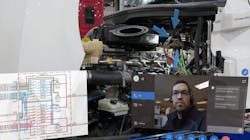Technology and repair: How DTNA leverages augmented reality
Daimler Trucks North America (DTNA) recently announced the success of its initial pilot with Microsoft’s HoloLens augmented reality (AR) technology as a viable method of virtual collaboration with dealers and customers.
DTNA is continuing to test the integration of AR into their operations, and throughout this testing, the company’s approach has been clear – creating value.
“We really obsess over how are we adding to the value proposition we have with our business partners, the dealers, and their technicians,” says Daoud Chaaya, director, field service, DTNA. “Technicians, being the hot commodity that they are, much like truck drivers these days, it's hard to get one in the door, and then the training scale or getting them up to speed and making sure they're hitting the ground running is also a concern we're trying to assist with… We want to continue to be on the cutting edge of innovation. How do we add to that value proposition? We see where we're at right now [with] HoloLens 2.0 and how much value we can add to our technicians to speed up repairs, increase uptime.”
Chaaya spoke to the approach and strategy DTNA has implemented to develop this program. Some initial insight came from Daimler’s passenger car business, which has been on a similar journey with AR integration.
“In terms of learning from what they’ve been through and taking lessons there, we leveraged that in the very beginning,” Chaaya says. “But by no means is it a copy and paste from our end. We want to see what, for the commercial vehicle space, needs to apply… With initial focus being on ‘How do we learn what infrastructure exists today? What do we need for the future? How much disruption is there going to be? Are we truly adding value?’”
The pilot program has provided answers to some of these questions posed.
Communication and collaboration
Participating dealers and technicians have been enthusiastic and open-minded about the HoloLens program.
Through this continuously refined process of communication, DTNA has aligned the use of the HoloLens similarly to when a technician would contact the call center today. There is a certain “checklist” that is reviewed upfront when technicians contact the call center, with tickets filed. When a call center representative receives a call from a tech donning a HoloLens headset, the individual in the call center already has some knowledge of the technician’s situation.
“The focus is how do we minimize downtime and how do we maximize uptime,” Chaaya says. “It’s not [achieved] through the technician teaching the call center representative what they’re seeing, so this [system of communication] allows the call center rep to come to the call prepared.”
A substantial benefit to the HoloLens system is the ability for the call center representative to bring in a subject matter expert when needed. The ability to have multiple people with “eyes” on the issue , and particular expertise addressing the matter, lends to clearer communication and expediting of processes.
“From the moment the technician puts their headset on, at a minimum, they have a call center on the other line guiding for repair and leveraging augmented reality to be able to parlay into the discussion service bulletins, service manuals, anything necessary for that particular issue that they’re facing, and fault codes that they see that they want to show the technician documentation of on the fly,” Chaaya explains. “This also allows for subject matter experts to be a part of that call. If we’re talking about an HVAC issue, and I want to rope in my HVAC engineer, they can also be virtually part of that call – this way, you get to bring in expertise, as needed, into a particular repair.”
This virtual connection and collaboration bodes well for many aspects of the maintenance environment. Particularly, troubleshooting single repairs becomes a unified effort across multiple channels. However, the technology can be applied to additional shop or technician needs, such as training.
“We’re looking to explore both avenues,” Chaaya says. “Number one, how can we be there with the technician in real time without physically being there – especially in times like this where safety is of the utmost concern – how do we make sure that we’re safely engaging with the technician? Likewise, another point we’re knee-deep into exploring is what kind of content can we populate? You can basically create a content channel through the HoloLens for training purposes and onboarding of technicians. In a way, it’s gamifying of repairs.”
Adoption challenges and successes
With an aging workforce holding leadership positions and a new generation of technicians being introduced to the industry, DTNA has remained aware of the varying levels of aptitude and eagerness for such a new concept.
Chaaya explains that through the testing of the HoloLens platform, the team has been working with technicians of varying capabilities and comfort when it comes to using this technology. He also claims that when the technology is used correctly, the learning curve is quick to get up to speed and have the ability to use that technology to one’s advantage as a technician.
Through piloting the HoloLens, feedback on usage has been crucial in creating something that works for everyone involved. Initially, some users felt that the goggles were “flimsy.” Some from the call center felt dizzy as they watched the technician crawl under a vehicle and look up, down, and around. Tweaks to the headset assured that there was a certain weight and feeling of sturdiness to the wearer; stabilization of the vision prevented the nauseating tracking concerns.
“The goggles [have] come a long way and we feel that the way we're approaching it strategically and also surgically, looking at different topics at a dealership level, at the technician level at the shop, is also helpful,” Chaaya says. “We're not just throwing it to the other side in hopes that it sticks. We're also looking to learn and adjust as we go alongside the dealers on this journey.”
As the testing and integration of such technology is scaled up, DTNA is collecting data from lessons learned and adjusting accordingly. Additionally, the company is exploring other use cases for this virtual and collaborative technology. From mobile services having a roadside technician connect with someone from their dealership, to conferencing in subject matter experts during a troublesome repair in-house, to the onboarding of new hires – the applications of the HoloLens are viable and are happening today.
“I foresee a group of connected people helping each other out,” Chaaya says of the HoloLens AR technology. “Long gone are the days where I need you to send me an email that has a video… The video is clear, or the video is not clear, and we spend hours sending content back and forth, and people throwing their hands up in the air in frustration, not being able to address complex repairs… This is a special tool at the dealership that allows them to connect with DTNA in real time and maximize uptime through quick goals… It can either end up being a cool tool that sits on somebody's shelf, or if leveraged correctly, really adds value, makes money, and leverages and pushes uptime.”
About the Author
Tyler Fussner
Associate Editor | Fleet Maintenance
Tyler Fussner is Managing Editor - Community Manager at Supply Chain Connect, part of the Design & Engineering Group at Endeavor Business Media.
Previously, Fussner served as the Associate Editor for Fleet Maintenance magazine. As part of Endeavor's Commercial Vehicle Group, his work has been published in FleetOwner magazine, as well as Bulk Transporter, Refrigerated Transporter, and Trailer-Body Builders.
Fussner's May 2022 print feature 'The dawn of hydrogen trucks' was named the best single technology article in B2B by the judges of the 2022 Folio: Eddie and Ozzie Awards. Fussner was also awarded Silver in the Technical Article category for the Trade Association Business Publications International (TABPI) 2021 Tabbie Awards.
Fussner previously served as Assistant Editor for Endeavor's Transportation Group on the PTEN, Professional Distributor, and VehicleServicePros.com brands.
Fussner studied professional writing and publishing at the University of Wisconsin-Whitewater. He has experience in shop operations, is a Michelin Certified Tire Technician, and a Michelin Certified Tire Salesperson.

